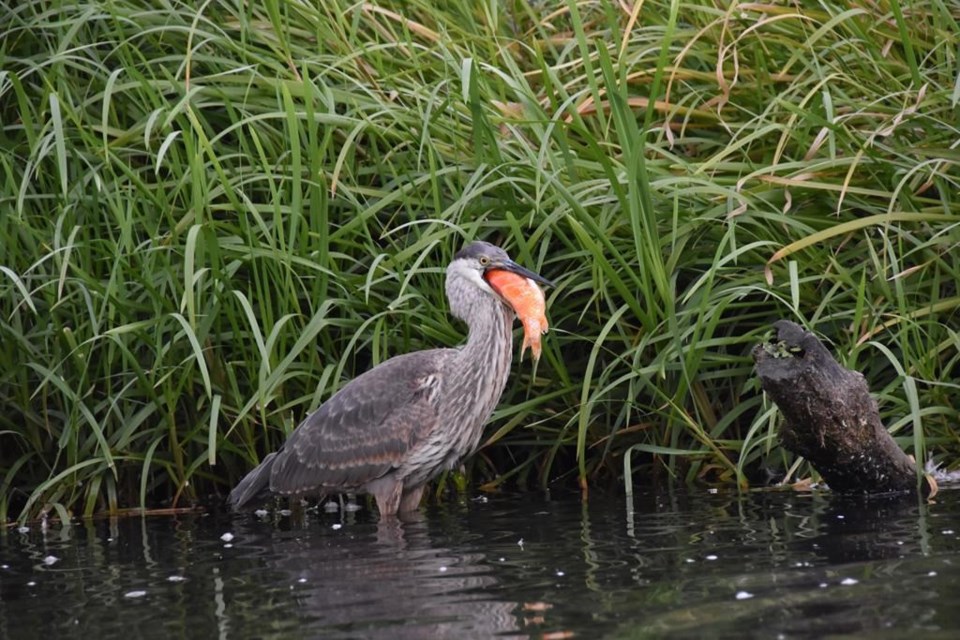KAMLOOPS, B.C. — Goldfish — some nearly as big as a football — are invading British Columbia's lakes and quickly spreading, putting native fish populations at risk, a researcher says.
Brian Heise, an associate professor in the department of natural resource sciences at Thompson Rivers University, says thousands of large, invasive goldfish have multiplied in bodies of water around the province.
"They're not the little fish you see in the pet store. They actually get quite large, and they have the potential to get even larger, especially probably in some warmer, more productive waters," he said.
Heise, a former chair of the Invasive Species Council of B.C., said female goldfish, often illegally dumped by people looking to get rid of a pet, can release 50,000 eggs at a time, three times a summer.
"Females don't even need a male (to reproduce). They have a special process called gynogenesis in which the female will get the sperm from a different kind of minnow ... to start the eggs developing, even though they're not fertilized," he said.
"And so she produces clones of herself. So, they're very good at spreading rapidly."
The goldfish compete with native species for food and space, and carry parasites and diseases that can spread to other fish, including the salmon population, he said.
Over the last decade, Heise said goldfish populations have spread from the Vancouver area to lakes in the northern and Interior parts of the province.
One of the most common ways to capture goldfish is through a process called electrofishing.
An electric current is passed through the water to stun the fish, allowing them to be scooped up.Heise said the method allows native fish to be easily revived and goldfish removed.
"The downside is that you're not killing all the fish. Therefore, you have to keep doing it again and again and again," he said.
"And it's actually quite an expensive process. To go into a lake and shock for a couple of days would probably cost you $10,000."
In a statement, B.C.'s Ministry of Water, Land and Resource Stewardship said a three-year electrofishing program at Dragon Lake in Quesnel that ended last year removed just over 6,000 goldfish.
The ministry said staff in the region are typically aware of infestations "and take a risk-based approach to determining actions."
It said goldfish have not proven to have a significant impact on the lake's rainbow trout population which has remained stable in the fishery.
"In addition to electrofishing, 6,000 yearling Horsefly strain rainbow trout have been added to the stocking regime annually since 2020. This strain of rainbow trout is highly adapted to feeding on fish and are now large enough to prey on goldfish," the statement says.
"Presently, the ministry is not planning on continuing the electrofishing program. The ministry will continue with the annual stocking of horsefly strain rainbow trout."
The statement says the government monitors the rainbow trout population annually to detect changes and has increased the distribution of educational materials to prevent pet owners from releasing their goldfish.
Heise said while the trout in Dragon Lake eat goldfish, there are other strains of rainbow trout in other lakes that don't.
"So instead of eating the little fish and getting big, they're having their food taken away by the goldfish. It's not a simple situation."
He said the province needs to fund electrofishing efforts where goldfish could be threatening trout and salmon but it also needs to work with pet stores and the pet industry so customers can return unwanted animals instead of dumping them.
"I think that if pet stores are bringing in exotic animals, and they're selling them to the public, it behooves them to then follow up and make sure that the public realize that you can't put these creatures in the wild once you finish," he said.
"It doesn't matter whether it's a snake, a turtle, a bird or a fish, you just can't put it into the wild. It's often going to be harmful to that animal because they're not adapted to that place, but also we're going to harm our local animals and plants."
— Ashley Joannou in Vancouver
This report by The Canadian Press was first published March 3, 2023.
The Canadian Press



